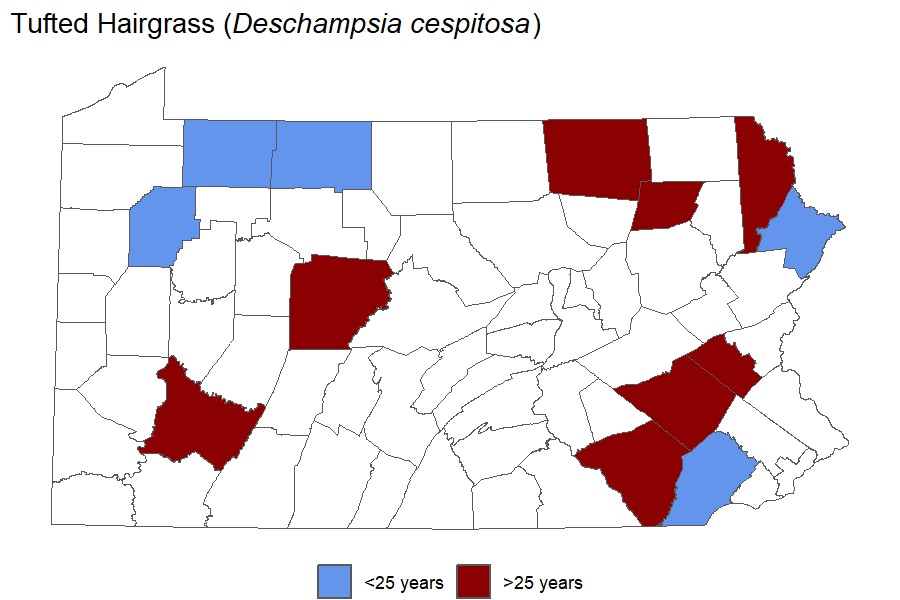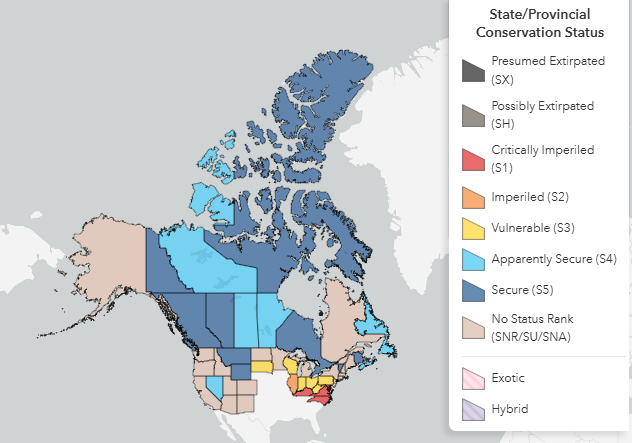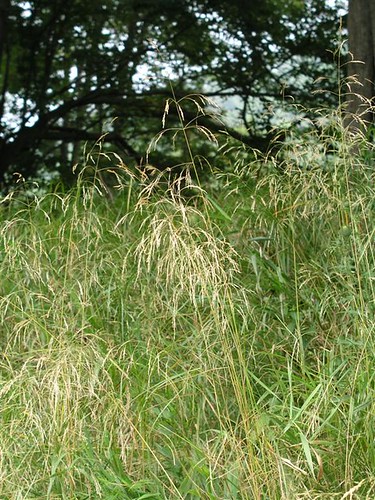 Species Factsheets
Species Factsheets
Deschampsia cespitosa
Tufted Hairgrass
State Status: N
PBS Status: Pennsylvania Threatened (PT)
Federal Status:
Global Rank: G5
![]() rank interpretation
rank interpretation
State Rank: S3
Did You Know?
This species is useful for acid and heavy metal mine reclamation and stabilizing disturbed streambanks or shorelines.
Description
Tufted hairgrass (Deschampsia cespitosa) is a perennial grass that grows over 1m in height. The leaves are arranged alternately, linear in shape, elongate, narrow (1-5mm in width), and tend to be clumped at the base of the plant in a tufted manner. The tiny individual flowers, appearing in May and June, are grouped in pairs in spikelets that are 2.5-5.5mm in length and are scattered in an open branched terminal grouping that stands above the leaves. The spikelets are often tinged with purple.
Rank Justification
Vulnerable in the nation or state due to a restricted range, relatively few populations (often 80 or fewer), recent and widespread declines, or other factors making it vulnerable to extirpation.
PABS
The PA Biological Survey (PABS) considers tufted hairgrass to be a species of special concern, based on the few occurrences that have been recently confirmed. It does not have a PA legal rarity status, but has been assigned a PABS suggested rarity status of Undetermined. About ten populations are currently known from the state.
Habitat
It grows in various habitats, including serpentine barrens, riverbed scours, marshes, damp openings, and along streams.
Survey Dates
Flowers late May - June
Distribution
In Pennsylvania, it has been documented historically in several widely scattered, particularly eastern, counties.

Threats
Invasive species may be a threat in some locations.
Management
The viability of the populations on serpentine barrens will require maintaining early successional, grassland conditions and controlling invasive species. Active management, such as the use of fire, scraping the substrate, or mowing, may be needed to create the proper successional stage and ecological conditions for this species to thrive. The riverine populations of tufted hairgrass will require maintaining the natural hydrology of the stream, with its seasonal fluctuations in water levels, as well as retaining the natural conditions of the shorelines and islands. The viability of populations in wetlands may be enhanced by establishing buffers around wetlands, controlling invasive species, and protecting the natural hydrology surrounding wetlands.
Conservation Status Map

NatureServe. 2017. NatureServe Explorer: An online encyclopedia of life [web application]. Version 7.1. NatureServe, Arlington, Virginia. Available https://explorer.natureserve.org.
https://plants.usda.gov/factsheet/pdf/fs_dece.pdf
- NatureServe. 2018. NatureServe Explorer: An online encyclopedia of life [web application]. Version 7.1. NatureServe, Arlington, Virginia. Available at https://www.natureserve.org/explorer
- Pennsylvania Natural Heritage Program. 2018.
- Rhoads, A.F. and W.M. Klein, Jr. 1993. The Vascular Flora of Pennsylvania. American Philosophical Society, Philadelphia, Pennsylvania. Rhoads, A.F. and T.A. Block.
- 2007. The Plants of Pennsylvania: An Illustrated Manual. 2nd edition. University of Pennsylvania Press, Philadelphia, Pennsylvania.







